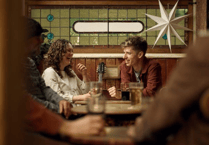“Everyone thinks it’s just a blank tunnel,” said Jim Parkin, tunnel supervisor at Kier, early last Thursday in the Hindhead Tunnel control room.
“But keeping it open is such a big operation. Most drivers don’t appreciate what happens and until you explain what happens behind the scenes they have no idea.”
These days, most of the 43,000 motorists who use the Hindhead Tunnel daily take it for granted. It’s certainly made a world of difference for the countless motorists who remember the days of queuing around the Devil’s Punchbowl.
But even though it’s made life so much better for people above and below, we still moan about it. Why does it close so often? Why is there a 40mph limit? Why can’t a contraflow be in place when one of the boreholes closes?

All these questions and more were answered by a National Highways team as the Herald & Post was given the rare opportunity to get a behind the scenes look at what happens when the tunnel closes.
Our adventure starts at 8pm in the control centre with a quick briefing about why we’ve been invited. The centre is the brownish bunker to the left of the southbound entrance to the tunnel, while the similar building on the Hindhead and Grayshott side is a backup.
It's not the easiest place to get to as it’s accessed by a country lane via the Thursley turn-off. But thankfully, a pair of Hindhead Tunnel legends cottoned on to my unfamiliarity and led the way to the nerve centre.
“We love tunnels,” said Jordan Cummings, team manager at Hindhead Control Room and the daughter of Debbie Wood, a National Highways tunnel safety officer who has worked at the landmark since it opened in 2011.

“I love the job because every day is different. When I tell people I work at the Hindhead Tunnel they say, how? But there’s so much people don’t know about.”
The Horndean duo are Hindhead Tunnel royalty as Debbie was the first civilian to travel through the tunnel as she bagged the passenger seat in the police car that made the inaugural journey. And to make it even more of a family affair, the 48-year-old – called “Mum” by Jordan and the team – also met her now-husband here.
Our visit coincides with a week of closures on the southbound A3 with the tunnel closing overnight from 10pm last Wednesday, November 19, to 6am the following morning for essential maintenance.
After getting a hi-vis makeover and donning a hard hat, the first stop on the visit is the control room. Every inch of the tunnel is covered by CCTV with a wall of 16 screens each showing live footage from different points.

National Highways staff monitor everything in this room from weather and ventilation to conditions and incidents on highways throughout the South East.
Theo Demetrious, control room operator, is among those keeping watch. The screens on the far left show the entrances to the Alpha and Beta tunnels (southbound and northbound) with the remainder focusing on the interior.
He said: “There are six radar heads in the tunnels and they can detect pedestrians and stopped vehicles.
“We will see something nine times out of ten before we get a call. We’ll know if anything is happening in there.”
Occasionally they’ll stop pedestrians and cyclists trying to get through while Theo says a tent has been the strangest thing to bring traffic to a half during his tenure.

He said: “At the side we saw something floating along in lane one and it turned out to be a tent.
“A member of the public moved and put it on the other side of the barrier but then the wind picked it up and then blew along the carriageway. It was half an hour before the police came along and removed it.”
The radar system is one of the reasons why the speed limit may suddenly reduce from 70 down to 40mph.
If it detects an unknown object, an alarm is triggered and the speed limit is automatically reduced, much like the system on smart motorways. Litter is a regular culprit with the silver lining of a crisp packet often catching its eye.
And regardless if the speed limit is either 40 or 70, the average speed camera setting will be set to that limit. You have been warned.
We also learn you can overtake in the tunnel as the white line in the middle is not completely solid.

Keeping the tunnel operational is like painting the Forth Bridge as maintenance work takes place every 12 weeks with a huge range of tasks being routinely carried out.
The tunnels are washed and swept frequently, for instance, and that’s before we talk about the night’s work, which includes upgrading cross barriers.
Around 30 workers are here on a bitterly cold night and the debriefing is eye-opening. Dozens of jobs were reeled out with lighting, jet fans, emergency telephones and cameras all being checked and repaired by the workforce.
And as the tunnel is 1.2miles long, that’s a lot of checking to do on just one side. Contraflows aren’t always an option in case of emergencies, with safe access being always needed in the confined space. And the diversions via Farnham and Bordon are necessary because all vehicles can use the A31 and A325.
“Your phone needs regular updates as there’s so much equipment and technology in there,” said Debbie.

“It’s the same with the tunnels: they have to be updated, swept, cleaned and made sure everything is working.
“If there’s a fire we will shut the whole tunnel. Anyone in the tunnel will evacuate through one and the emergency services will enter through the other one.
“We will put a contraflow if there’s an incident that’s going to last more than three hours and we’ve got a PA system which plays recorded messages and can do free speech.”
One of the reasons for tonight’s visit is to reduce the number of breakdowns in the tunnel, which happens at least once a week, with tyre issues and empty fuel tanks being the top two reasons.
It’s worth highlighting at this point the National Highways TRIP campaign, with the abbreviation standing for Top-up (fuel, oil, screen wash), Rest (every 24 hours), Inspect (tyres) and Prepare (for weather).

If you do get stuck in the tunnel, you won’t get a signal unless you’re with Vodafone so chances are you’ll have to take shelter at one of the safety points and use the emergency roadside telephone. And if you break down in the tunnel, you will have to organise recovery as National Highways don’t provide the service here.
Although the nocturnal team that carried out work are the unsung heroes, Debbie and Jordan were the stars of the night, with the pair loving their work-life balance and relationship.
And when they jokingly say “we love tunnels” you get the impression they’re not joking.
“Oh yeah, we rate tunnels and have our favourites,” said Jordan sometime after midnight.
“We love this one but some we think are horrible,” with Jordan shuddering at the mention of Blackwall and Rotherhide. If you know, you know.




Comments
This article has no comments yet. Be the first to leave a comment.